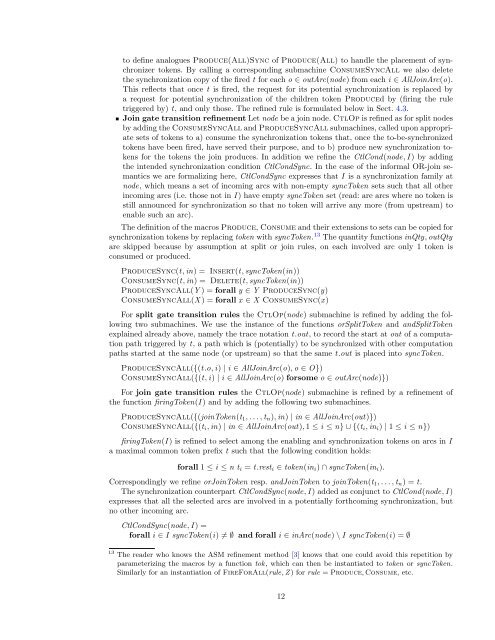BPMN and Beyond Business process modelling notation, workflow ...
BPMN and Beyond Business process modelling notation, workflow ...
BPMN and Beyond Business process modelling notation, workflow ...
Create successful ePaper yourself
Turn your PDF publications into a flip-book with our unique Google optimized e-Paper software.
to define analogues Produce(All)Sync of Produce(All) to h<strong>and</strong>le the placement of synchronizer<br />
tokens. By calling a corresponding submachine ConsumeSyncAll we also delete<br />
the synchronization copy of the fired t for each o ∈ outArc(node) from each i ∈ AllJoinArc(o).<br />
This reflects that once t is fired, the request for its potential synchronization is replaced by<br />
a request for potential synchronization of the children token Produced by (firing the rule<br />
triggered by) t, <strong>and</strong> only those. The refined rule is formulated below in Sect. 4.3.<br />
Join gate transition refinement Let node be a join node. CtlOp is refined as for split nodes<br />
by adding the ConsumeSyncAll <strong>and</strong> ProduceSyncAll submachines, called upon appropriate<br />
sets of tokens to a) consume the synchronization tokens that, once the to-be-synchronized<br />
tokens have been fired, have served their purpose, <strong>and</strong> to b) produce new synchronization tokens<br />
for the tokens the join produces. In addition we refine the CtlCond(node, I ) by adding<br />
the intended synchronization condition CtlCondSync. In the case of the informal OR-join semantics<br />
we are formalizing here, CtlCondSync expresses that I is a synchronization family at<br />
node, which means a set of incoming arcs with non-empty syncToken sets such that all other<br />
incoming arcs (i.e. those not in I ) have empty syncToken set (read: are arcs where no token is<br />
still announced for synchronization so that no token will arrive any more (from upstream) to<br />
enable such an arc).<br />
The definition of the macros Produce, Consume <strong>and</strong> their extensions to sets can be copied for<br />
synchronization tokens by replacing token with syncToken. 13 The quantity functions inQty, outQty<br />
are skipped because by assumption at split or join rules, on each involved arc only 1 token is<br />
consumed or produced.<br />
ProduceSync(t, in) = Insert(t, syncToken(in))<br />
ConsumeSync(t, in) = Delete(t, syncToken(in))<br />
ProduceSyncAll(Y ) = forall y ∈ Y ProduceSync(y)<br />
ConsumeSyncAll(X ) = forall x ∈ X ConsumeSync(x)<br />
For split gate transition rules the CtlOp(node) submachine is refined by adding the following<br />
two submachines. We use the instance of the functions orSplitToken <strong>and</strong> <strong>and</strong>SplitToken<br />
explained already above, namely the trace <strong>notation</strong> t.out, to record the start at out of a computation<br />
path triggered by t, a path which is (potentially) to be synchronized with other computation<br />
paths started at the same node (or upstream) so that the same t.out is placed into syncToken.<br />
ProduceSyncAll({(t.o, i) | i ∈ AllJoinArc(o), o ∈ O})<br />
ConsumeSyncAll({(t, i) | i ∈ AllJoinArc(o) forsome o ∈ outArc(node)})<br />
For join gate transition rules the CtlOp(node) submachine is refined by a refinement of<br />
the function firingToken(I ) <strong>and</strong> by adding the following two submachines.<br />
ProduceSyncAll({(joinToken(t 1 , . . . , t n ), in) | in ∈ AllJoinArc(out)})<br />
ConsumeSyncAll({(t i , in) | in ∈ AllJoinArc(out), 1 ≤ i ≤ n} ∪ {(t i , in i ) | 1 ≤ i ≤ n})<br />
firingToken(I ) is refined to select among the enabling <strong>and</strong> synchronization tokens on arcs in I<br />
a maximal common token prefix t such that the following condition holds:<br />
forall 1 ≤ i ≤ n t i = t.rest i ∈ token(in i ) ∩ syncToken(in i ).<br />
Correspondingly we refine orJoinToken resp. <strong>and</strong>JoinToken to joinToken(t 1 , . . . , t n ) = t.<br />
The synchronization counterpart CtlCondSync(node, I ) added as conjunct to CtlCond(node, I )<br />
expresses that all the selected arcs are involved in a potentially forthcoming synchronization, but<br />
no other incoming arc.<br />
CtlCondSync(node, I ) =<br />
forall i ∈ I syncToken(i) ≠ ∅ <strong>and</strong> forall i ∈ inArc(node) \ I syncToken(i) = ∅<br />
13 The reader who knows the ASM refinement method [3] knows that one could avoid this repetition by<br />
parameterizing the macros by a function tok, which can then be instantiated to token or syncToken.<br />
Similarly for an instantiation of FireForAll(rule, Z ) for rule = Produce, Consume, etc.<br />
12
















